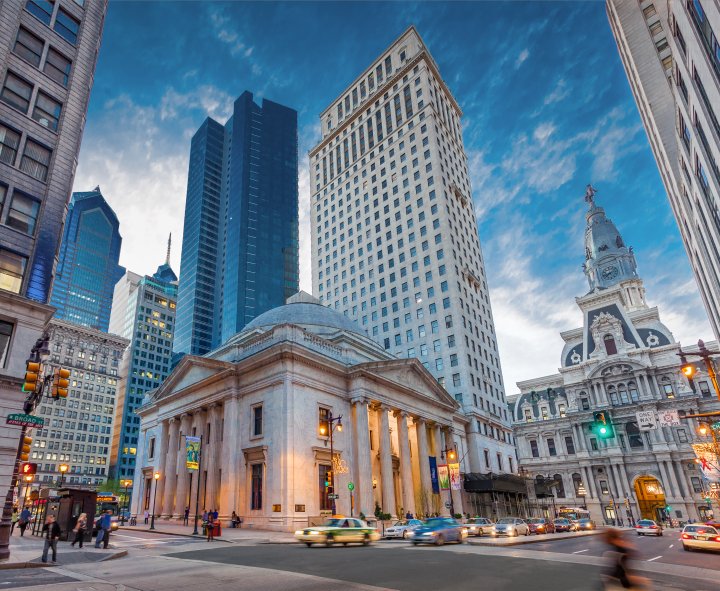The Ritz-Carlton
The Ritz-Carlton Philadelphia is a 330-room hotel located in a 30-story skyscraper in Center City, Philadelphia. The Ritz-Carlton is located in the structure that was originally known as the Girard Trust Building when it was built in 1931. The building is listed in the National Register of Historic Places and is therefore subject to the requirements of maintaining its original appearance and utilizing equivalent materials for restoration. The building’s façade was constructed with a marble stone veneer. The marble is anchored to the terracotta back-up and steel structure. A setback located at the 28th floor serves as a promenade and decorative balconettes are located at Floors 4, 12, and 19. The setback is detailed with a marble cornice and parapet wall and the balconettes are detailed with marble railings and spindles.
Philadelphia passed a façade law similar to New York’s, Boston’s, Columbus’s, St. Louis’s, and Chicago’s façade laws. O&S was hired to provide the engineering services to inspect the exterior walls and determine the best course of action to repair and maintain this prestigious façade.
Ritz-Carlton hired O&S Associates to perform an exterior envelope inspection of the building in order to assess the existing conditions and propose a repair program. O&S performed a hands-on inspection of the entire façade utilizing suspended scaffolding. O&S also performed a survey of the roof.
O&S prepared construction drawings and documents for restoration in compliance with Philadelphia’s requirements for historic buildings. O&S filed the necessary paperwork with the Department of Buildings and received approval for construction. Structural Group performed general contracting with O&S acting as construction manager. The original estimate for the construction cost was $1.5 million. O&S and Structural worked together to create additional value and were able to submit a winning bid of $857,000.
Special Features
As a Historic Building, O&S and Structural had to develop a repair program that utilized materials matching the existing construction and resulted in a finished appearance that matched the original construction. In order to perform the inspection, O&S utilized Infrared Thermography in addition to visual observations. Infrared Thermography is a non-destructive testing technique using an Infrared (IR) camera. IR Thermography can detect moisture infiltration, insulation saturation, interlaminar saturation, insufficient insulation, and air leaks that are not visible to the naked eye.
The primary repairs were related to the marble façade which had deteriorated due to weathering. The marble surface had deteriorated in many locations due to freeze-thaw damage. The repair called for cleaning the deteriorated surface to sound material and then sealing it with a glazing compound. Deteriorated also occurred around original architectural details in the marble which called for specialized marble craftsmanship to repair. Displaced marble panels were also discovered which represented an immediate safety concern. Sidewalk sheds were installed in order to protect pedestrians on the sidewalk below. The repair for displaced marble panels called for removing the displaced panel, installing masonry anchors, and reinstalling the panel. The marble railing around the balconette was also discovered to be deteriorated. The loose or deteriorated marble was removed with chipping hammers and patched with colored mortar to match the existing surface. All of the marble repairs required mock-ups which were approved by the Philadelphia Historic Commission before repairs could proceed.
The parapet walls at the 28th floor were also found to be in poor condition. The cast-stone veneer was deteriorated by freeze-thaw damage and the ornamental carvings were cracked and in danger of collapse. Sidewalk sheds were again installed to protect pedestrians from falling stone. The repairs required taking detailed measurements and photographs of the stone details and carvings in order to create shop drawings. Shop drawings were created and approved by the Philadelphia Historic Commission and replacement pieces were created in the same material.
O&S Project Engineers performed all scaffold drops in order to lay out work in the field and to verify the quality and quantity of completed work.
The Construction Phasing of the Project
The first phase of the project involved protecting the public from potentially collapsing façade material. Sidewalk sheds, fencing, and signing were used to protect the sidewalk and building entrances. The next phase involved laying out all of the proposed work in the field. This was performed jointly by O&S and Structural. Since this was historic work, every work item required a mock-up performed in the field to be approved by the Philadelphia Historic Commission. At this time, measurements were also made of all ornamental pieces which required fabrication and had a long lead time. Once all approvals were received, construction proceeded on the deteriorated marble surface, displaced panels, veneers and ornamental pieces. In the last phase, O&S and the Philadelphia Historic Commission reviewed the work to verify its quality, quantity, and historical accuracy. A punchlist was created of omitted work items or work items that required revision in the field.
